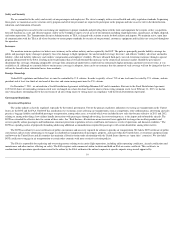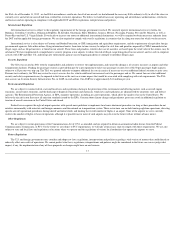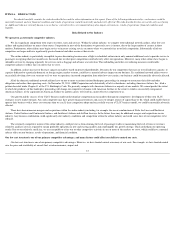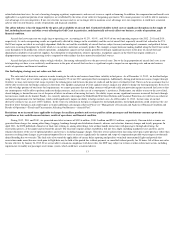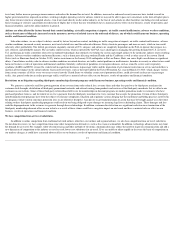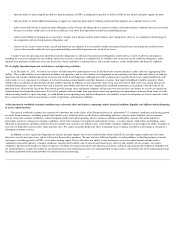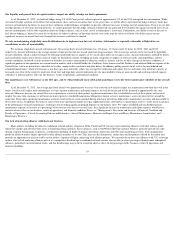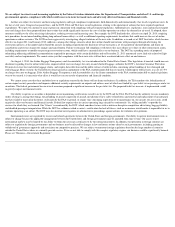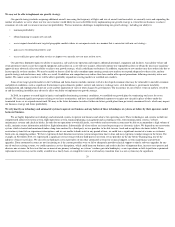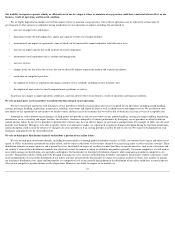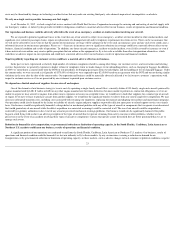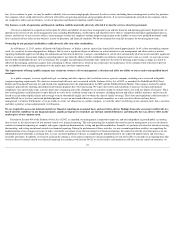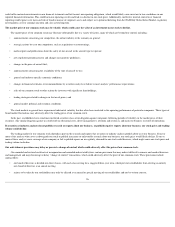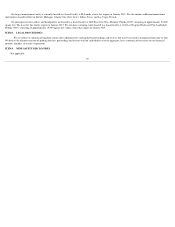Spirit Airlines 2012 Annual Report Download - page 21
Download and view the complete annual report
Please find page 21 of the 2012 Spirit Airlines annual report below. You can navigate through the pages in the report by either clicking on the pages listed below, or by using the keyword search tool below to find specific information within the annual report.
We may not be able to implement our growth strategy.
Our growth strategy includes acquiring additional aircraft, increasing the frequency of flights and size of aircraft used in markets we currently serve and expanding the
number of markets we serve where our low cost structure would likely be successful. Effectively implementing our growth strategy is critical for our business to achieve
economies of scale and to sustain or increase our profitability. We face numerous challenges in implementing our growth strategy, including our ability to:
Our growth is dependent upon our ability to maintain a safe and secure operation and requires additional personnel, equipment and facilities. An inability to hire and
retain personnel, timely secure the required equipment and facilities in a cost-effective manner, efficiently operate our expanded facilities or obtain the necessary regulatory
approvals may adversely affect our ability to achieve our growth strategy, which could harm our business. In addition, expansion to new markets may have other risks due to
factors specific to those markets. We may be unable to foresee all of the risks attendant upon entering certain new markets or respond adequately to these risks, and our
growth strategy and our business may suffer as a result. In addition, our competitors may reduce their fares and/or offer special promotions following our entry into a new
market. We cannot assure you that we will be able to profitably expand our existing markets or establish new markets.
Some of our target growth markets in the Caribbean and Latin America include countries with less developed economies that may be vulnerable to unstable economic
and political conditions, such as significant fluctuations in gross domestic product, interest and currency exchange rates, civil disturbances, government instability,
nationalization and expropriation of private assets and the imposition of taxes or other charges by governments. The occurrence of any of these events in markets served by
us and the resulting instability may adversely affect our ability to implement our growth strategy.
In 2008, in response to record high fuel prices and rapidly deteriorating economic conditions, we modified our growth plans by terminating our leases for seven
aircraft. We incurred significant expenses relating to our lease terminations, and have incurred additional expenses to acquire new aircraft in place of those under the
terminated leases as we expand our network. We may in the future determine to reduce further our future growth plans from previously announced levels, which may impact
our business strategy and future profitability.
We rely heavily on technology and automated systems to operate our business and any failure of these technologies or systems or failure by their operators could
harm our business.
We are highly dependent on technology and automated systems to operate our business and achieve low operating costs. These technologies and systems include our
computerized airline reservation system, flight operations system, financial planning, management and accounting system, telecommunications systems, website,
maintenance systems and check-
in kiosks. In order for our operations to work efficiently, our website and reservation system must be able to accommodate a high volume of
traffic, maintain secure information and deliver flight information. Substantially all of our tickets are issued to passengers as electronic tickets. We depend on our reservation
system, which is hosted and maintained under a long-term contract by a third-party service provider, to be able to issue, track and accept these electronic tickets. If our
reservation system fails or experiences interruptions, and we are unable to book seats for any period of time, we could lose a significant amount of revenue as customers
book seats on competing airlines. We have experienced short duration reservation system outages from time to time and may experience similar outages in the future. For
example, in November 2010, we experienced a significant service outage with our third-party reservation service provider on the day before Thanksgiving, one of the
industry’s busiest travel days. We also rely on third-party service providers of our other automated systems for technical support, system maintenance and software
upgrades. If our automated systems are not functioning or if the current providers were to fail to adequately provide technical support or timely software upgrades for any
one of our key existing systems, we could experience service disruptions, which could harm our business and result in the loss of important data, increase our expenses and
decrease our revenues. In the event that one or more of our primary technology or systems’ vendors goes into bankruptcy, ceases operations or fails to perform as promised,
replacement services may not be readily available on a timely basis, at competitive rates or at all and any transition time to a new system may be significant.
20
•
maintain profitability;
•
obtain financing to acquire new aircraft;
•
access airports located in our targeted geographic markets where we can operate routes in a manner that is consistent with our cost strategy;
•
gain access to international routes; and
•
access sufficient gates and other services at airports we currently serve or may seek to serve.


